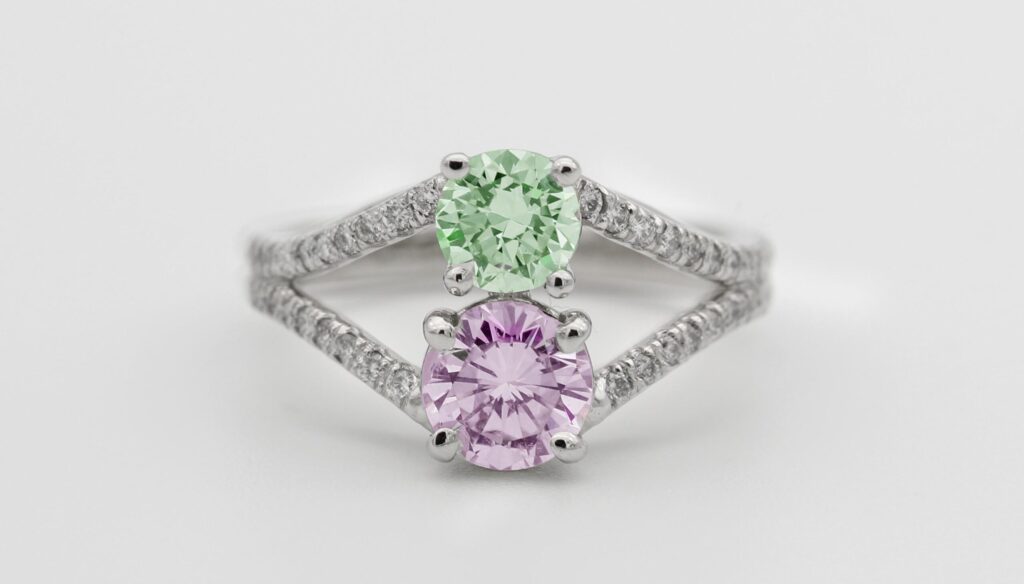
From Ancient Rome to Modern Times: Colorful Gemstones Can Be Engagement Rings And Why Diamonds Are Overrated for Some
The tradition of giving a diamonds for engagement rings dates back to the 1400s when Archduke Maximilian of Austria gave a diamond ring to Mary of Burgundy. Although, diamonds for engagement rings is still the most popular choice for couples, there’s an increasing number of brides who are looking for something different.
Whether for personal or ethical reasons or to stand out from the crowd, more and more couples are turning to alternative gemstones for their engagement rings.
From colorful sapphires to brilliant moissanite, many beautiful and unique options are available for those wanting to break tradition.
Some popular alternatives to diamonds for engagement rings include:
- Moissanite: Moissanite is a lab-created gemstone that looks similar to a diamond but is more affordable. It is known for its brilliance, fire, and durability.
- Sapphire: Sapphire is a precious gemstone that is available in a range of colors, including blue, pink, yellow, and green. It is also durable and has a high level of brilliance.
- Ruby: Ruby is a precious gemstone known for its deep red color. It is also durable and has a high level of brilliance.
- Emerald: Emerald is a precious gemstone known for its deep green color. It is also durable, but may require more care than other gemstones.
- Aquamarine: Aquamarine is a pale blue gemstone known for its calming and soothing energy. It is also durable and has a high level of brilliance.
- Tanzanite: Tanzanite is a rare gemstone in shades of blue and purple. It is also durable and has a high level of brilliance.
- Opal: Opal is a unique gemstone that is available in a range of colors, including white, black, and orange. It is known for its iridescent quality and is considered a delicate gemstone requiring special care.
- Tourmaline: Tourmaline is a colorful gemstone that is available in a range of colors, including pink, green, and blue. It is also durable and has a high level of brilliance.
Did you know?
Colored gemstones for engagement rings is that some stones are believed to have special meanings or powers. For example, in ancient times, it was thought that sapphires could protect their wearer from harm, while rubies were said to bring good luck and happiness.
Recently, some people have turned to colored stones like aquamarine or tourmaline, believed to have calming or healing properties. This adds an extra layer of meaning and symbolism to the choice of a colored stone for an engagement ring, making it a beautiful and meaningful accessory.
A little history:
The use of colored gemstones for engagement rings can be traced back to ancient civilizations. In ancient Rome, for example, brides were given rings that featured colored stones, such as emeralds or sapphires, in addition to or instead of diamonds.
In ancient Greece, it was believed that wearing a ruby ring would protect the wearer from harm, and in India, it was traditional to use colored stones like rubies and emeralds in engagement rings.
The modern trend of using colored stones in engagement rings can be traced back to the 19th century. At this time, diamonds were not yet the dominant choice for engagement rings, and many people chose to use colored gemstones instead.

Queen Victoria, for example, was given a sapphire and diamond engagement ring by Prince Albert in 1840, which helped popularize the use of colored stones in engagement rings.
In the early 1900s, diamonds became more widely available and affordable, and they began to eclipse colored stones as the most popular choice for engagement rings.
In recent years, there has been a resurgence of interest in colored stones as couples seek out unique and meaningful alternatives to traditional diamond rings.
There are a wide variety of colored stones available for engagement rings, ranging from classic sapphires and rubies to more unusual stones like tourmaline and morganite.



